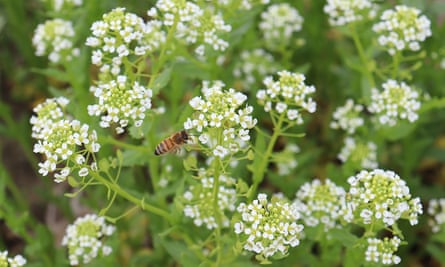In an asphalt-surrounded greenhouse at the back of a business park in Hayward, California, on the shores of San Francisco Bay, a sea of more than 200 leafy, green, hybrid poplar saplings are itching to break free from their pots. Among them stands Maddie Hall. The trees are all “mother trees”, explains Hall, co-founder and CEO of climate biotech firm Living Carbon. They have been genetically altered (there are about 100 different lines) with the aim of making them better at absorbing carbon dioxide (CO2). The startup company propagates cuttings from the mothers either to study or to send to nurseries for larger-scale production.
This spring, clones of four of its leading lines were planted on private land in Georgia and Ohio as pilot projects to monitor their carbon sequestration, through partnerships with willing landowners. Living Carbon’s business model includes selling carbon removal credits, with landowners paid for the use of their property. About 170,000 seedlings of different tree varieties were planted over about 120 hectares (300 acres), about 5% of which were genetically modified poplars: the company is starting small, conscious of avoiding monocultures. “None of what we do matters if it just all stays at the greenhouse,” says Hall.
There are projects under way around the world to genetically engineer plants – namely crops – for traits such as bigger yields, disease resistance or drought or heat tolerance. But efforts to engineer them to do better at drawing CO2 out of the atmosphere to fight the climate crisis directly are newer.
Living Carbon, founded in 2019 and which has received $36m in venture capital funding to date, is in the vanguard of establishing the technology in trees. Meanwhile, a handful of others, including two world-leading California-based scientific institutions, are tackling how it might be done in agricultural crops. Both the Salk Institute for Biological Studies in San Diego and the Innovative Genomics Institute (IGI) in Berkeley, a joint venture between the University of California, Berkeley and UC, San Francisco, have received large amounts of philanthropic funding.
The possible impact of this approach on global CO2 emissions is difficult to quantify – it depends on how significant the gains could be, and how widely it’s deployed. But its proponents are bullish that if scaled up it could make a significant contribution and buy the world some time.
Guzzling carbon
It is by increasing the efficiency of photosynthesis – the process by which plants use light, water and CO2 to make sugars that fuel plant growth (with oxygen as the byproduct) – that Living Carbon’s trees are able to capture more CO2 than they naturally would. Forests with their woody biomass and substantial rooting systems that last many decades are an important long-term carbon sink – if their trees can photosynthesise even better, that importance becomes supercharged.
But increasing the amount of photosynthesis done by a plant isn’t easy. Living Carbon gets round this by short-circuiting an inefficiency most plants also have which – contrary to the general pattern of photosynthesis – sees them regularly take up oxygen and give out some CO2 in daylight. Living Carbon tinkers with that process to channel that CO2 into tree growth. “We took a lot of learning from what had been shown to work well in crop plants and our big innovation was having a similar trait work in trees,” says Hall.
In a scientific paper published this April, the company reports that in a four-month-long greenhouse trial its modified poplars increased in biomass by 35-53% over its controls, equivalent to removing 17-27% more CO2 from the air. Several patents are now in the works, says Hall, and, in addition to the pilot plantings, a small field trial involving about 600 of the trees is under way at the University of Oregon to confirm the results.

All Living Carbon’s planting is intended to be done on degraded mining or agricultural land where no trees currently grow. It aims to plant about 2,400 hectares (6,000 acres), around 4m trees by the end of spring 2024 – roughly half of which will be photosynthesis-enhanced. But if it could scale that up to 1.6m hectares (4m acres) by 2030, that would mean – assuming a 40-year lifespan and that the enhanced trees guzzle carbon at the top rate observed in the greenhouse trials – more than 600 megatonnes of CO2 sequestered, which is about 1.6% of current global CO2 emissions. There’s a lot of potential given that there are 60m hectares (148m acres) of land available for reforestation in the US alone, says Hall. Living Carbon was able to move forward quickly with the pilots because US regulators ruled that the trees need not be regulated as genetically engineered plants: there was no risk the genes being inserted could make them more invasive.
Meanwhile, arming crops to be better at removing CO2 requires a different approach. They are shorter-lived and harvested seasonally; what’s left both above and below ground decomposes quickly, releasing CO2 back into the atmosphere. The focus for crops then is on engineering them so they are better able to store more carbon below ground for longer. It is also possible to stack traits – making plants better at both capturing and storing carbon.
Plant scientists at the Salk have been working to engineer crop plants they call “Salk Ideal Plants” since 2017, though it wasn’t until 2019 the project ramped up. The work, under the rubric of the Harnessing Plants Initiative (HPI), has received more than $127m in funding to date from the TED Audacious Project, the Bezos Earth Fund and the Hess Corporation, an oil and gas exploration and production company.
Soya beans, rice, wheat, corn, rapeseed/canola, sorghum and CoverCress (a strain of field pennycress) are the current target crops. That they are planted on so much land already means there is capacity to have a large impact, say plant scientists Joanne Chory and Wolfgang Busch, the HPI founding director and executive director respectively.
The focus is on modifying the crops in three ways that they hope will create dramatic changes. Those are: larger roots (more root mass means more carbon sequestered); roots that penetrate deeper into the soil (further down, microbial activity is lower so it takes longer to decompose and there are typically more minerals that the carbon can associate with to lock it away); and roots that produce more of a carbon-rich polymer called suberin. Produced by all land plants and the main component of cork, suberin is difficult for microbes to decompose so it could keep carbon locked underground far longer. “Salk Ideal Plants will be the world champions of carbon sequestration,” says Busch.
Although things will vary with soil type, the scientists aim to develop crops that will be able to stabilise about 30% of the carbon that gets fixed from the air in the soil, up from very little, and they hope to have the plants grow on about 70% of the area where they grow currently. Particularly thanks to suberin and deeper roots, at least some of that would remain for decades.

So far, the group have found tens of genes in other plants that they believe could enhance the traits, and they are now doing small-scale proof-of-concept experiments to test whether employing them in the crops or changing the equivalent genes in the crops can work. The aim is to make the plants available by the late 2020s or early 2030s and a company called Cquesta is being set up to take forward commercialisation.
Meanwhile, about 500 miles north of the Salk and not too far from Living Carbon’s greenhouse, is the IGI. It too has a crop effort under way, launched last year and funded by $11m from the Chan Zuckerberg Initiative. The goal is “taking more carbon out of the atmosphere, funnelling it into the soil and trying to keep it there”, says Brad Ringeisen, the IGI’s executive director. And it doesn’t start from scratch but brings together the ongoing work of several researchers at the IGI’s partner institutions in both roots and leaves.
Others on the scene include UK-based startup Wild Bio, a spin-out of Oxford University’s Oxford Centre for Plant Science Innovation, founded in 2021. It hopes to genetically alter crops to produce more food and leave behind more carbon in the soil, drawing inspiration from plants in the wild. Legislation passed this March, which removes crops that are gene edited only from the regulatory system for genetically modified organisms in England – the US made a similar move in 2021 – will help the company, says Ross Hendron, its co-founder and CEO. The new law allows genetic changes in crop plants that could have been produced naturally, or by traditional cross-breeding – while stricter regulations for introducing genetic material from other species remain in place.
Unproved at scale
Yet moving these new superpowered plants forward commercially faces hurdles, starting with demonstrating they work in the real world. While Living Carbon may be planning to scale up planting, it remains to be seen whether the carbon-sequestration gains seen in the greenhouse trials translate outside, where conditions such as temperature, available water and nutrients aren’t controlled, say experts. This environmental variability can make a “huge difference” to how things grow, says Christine Raines, a professor of plant biology at the University of Essex. It will also, she adds, take time to see – because conditions can change markedly from one year to the next.
There are other factors. It has been found, for example, that trees now growing in warmer conditions because of climate change grow faster because they suck up more CO2 anyway – though the trade-off is that they might die sooner.
Meanwhile for the Salk project, suberin – touted as a star for its potential to store carbon longer-term in the soil – may not work out as hoped. A possible problem noted by Raines and others is that by locking away carbon, it could reduce what’s available to the crop to put towards yield. It may also interfere with root performance. The Salk scientists acknowledge there is work to do on suberin, and they are exploring how they might add enhanced photosynthetic efficiency to counter the potential yield problem.
Others doubt that developing such technology is the best way to proceed at all. There is no proof that it will work at scale, and it could take decades to develop, say campaign groups. Friends of the Earth Europe also says that no one knows the long-term impacts of modifying the genes of trees and plants through technologies. Better, they say, to focus on what has a proven record of cutting emissions – such as significantly increasing the number of trees and using low-till agriculture, which reduces soil disturbance and so promotes the storage of carbon in the soil naturally. “Like so many novel tech approaches to tackling CO2 … [the development of such plants] represents a significant distraction,” says Ben Raskin, the Soil Association’s head of horticulture and agroforestry.
Yet for the proponents of superpowering plants to directly counter the climate crisis, the world hasn’t been reducing emissions at the rate required, and even if it were to reduce them to zero tomorrow, it would still need to remove carbon. Hall adds it would be a shame if the technology was prevented from moving forward because of concerns about genetic modification not founded in science. “We are in a climate emergency,” she points out.

Comments (…)
Sign in or create your Guardian account to join the discussion